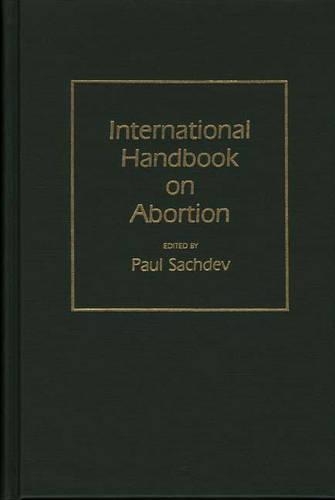
International Handbook on Abortion
(Hardback)
Publishing Details
International Handbook on Abortion
By (Author) Paul Sachdev
Bloomsbury Publishing PLC
Greenwood Press
28th June 1988
United States
Classifications
Tertiary Education
Non Fiction
363.46
Physical Properties
Hardback
532
Description
This handbook discusses 33 nations in terms of abortion's legal status, development of the policy, availability of contraception and abortion services, abortion rates, fertility trends, and the demographic/socioeconomic profiles of affected women. The amount of data consolidated in one volume is prodigious, providing information not readily available in any other single source. . . . In terms of policies and data, the book is excellent. Library Journal This unique work assembles in a single volume data from several continents on the general pattern of legal activity pertaining to abortion, as well as service delivery, the incidence of abortion, and the profile of aborting women. Each of the thirty-three essays in the Handbook surveys in depth the historical development of abortion policy; the role of the medical profession, news media, religious and women's organizations, and other groups in legislative enactments; and demographic data concerning women who seek abortions. Also dealt with are the relation between abortion, fertility behavior, and family planning policy and programs; the incidence of, complications from, and morbidity as a result of illegal abortions; and abortion research.
Reviews
A reference book in format, this Handbook offers detailed and sometimes surprising information; chapters on Belgium, Bangladesh, China, Poland, and Quebec are particularly interesting. Some patterns of abortion evident in the US are common worldwide: liberalization of the law; differential acceptance of hard' and soft' indications for abortion; replacement of illegal by legal abortions and of abortion by contraception; intrasocietal ethnic/racial variation in abortion utilization; an increasing proportion of abortions to single women; and an increase in repeat abortions as the population at risk increases. Where conservative resistance exists, it is expressed in a number of ways: pro-life' movements to limit abortion; retention of unenforced prohibitions; reliance on menstral regulation' rather than abortion.' A few nations continue to effectively criminalize abortion. Those cases are instructive, given the possible overturning of the American Roe v. Wade decision. Sachdev's introductory essay provides an excellent overview. Chapters include information on history, legal status, numbers of legal and illegal abortions, demographics, repeat abortions; attitudes, research, population programs, contraceptive use, and fertility. Data tables are appended. . . . This is a premier resource that ought to be in every library.-Choice
This handbook discusses 33 nations in terms of abortion's legal status, development of the policy, availability of contraception and abortion services, abortion rates, fertility trends, and the demographic/socioeconomic profiles of affected women. The amount of data consolidated in one volume is prodigious, providing information not readily available in any other single source. . . In terms of policies and data, the book is excellent.-Library Journal
This single volume assembles data from several continents on abortion including: the general pattern of the legal status, indications for abortion, service delivery, abortion incidence, fertility trends, and the profile of contracepting and aborting women. . . . The wide range of subject areas make the work immensely useful to various social studies disciplines, women's studies, and the behavioral sciences. Its negation of moral and religious aspects of abortion should appeal to academic and lay readers on both sides of the controversy.-American Journal of Public Health
"This handbook discusses 33 nations in terms of abortion's legal status, development of the policy, availability of contraception and abortion services, abortion rates, fertility trends, and the demographic/socioeconomic profiles of affected women. The amount of data consolidated in one volume is prodigious, providing information not readily available in any other single source. . . In terms of policies and data, the book is excellent."-Library Journal
"This single volume assembles data from several continents on abortion including: the general pattern of the legal status, indications for abortion, service delivery, abortion incidence, fertility trends, and the profile of contracepting and aborting women. . . . The wide range of subject areas make the work immensely useful to various social studies disciplines, women's studies, and the behavioral sciences. Its negation of moral and religious aspects of abortion should appeal to academic and lay readers on both sides of the controversy."-American Journal of Public Health
"A reference book in format, this Handbook offers detailed and sometimes surprising information; chapters on Belgium, Bangladesh, China, Poland, and Quebec are particularly interesting. Some patterns of abortion evident in the US are common worldwide: liberalization of the law; differential acceptance of hard' and soft' indications for abortion; replacement of illegal by legal abortions and of abortion by contraception; intrasocietal ethnic/racial variation in abortion utilization; an increasing proportion of abortions to single women; and an increase in repeat abortions as the population at risk increases. Where conservative resistance exists, it is expressed in a number of ways: pro-life' movements to limit abortion; retention of unenforced prohibitions; reliance on menstral regulation' rather than abortion.' A few nations continue to effectively criminalize abortion. Those cases are instructive, given the possible overturning of the American Roe v. Wade decision. Sachdev's introductory essay provides an excellent overview. Chapters include information on history, legal status, numbers of legal and illegal abortions, demographics, repeat abortions; attitudes, research, population programs, contraceptive use, and fertility. Data tables are appended. . . . This is a premier resource that ought to be in every library."-Choice
Author Bio
PAUL SACHDEV is Director of the MSW Program, Indiana University School of Social Work.
